Key Insights
- Given the overall market cool off, secondary sales of digital land parcels decreased 54% but are still up 865% from Q3 2021.
- Primary sales grew 23% from new parcel issuance.
- The Sandbox reached 2+ million registered users upon the launch of the Alpha Season 2 gameplay in March 2022.
- A gasless staking program launched on Polygon.
- The Sandbox focuses on partnerships across gaming, music, entertainment, and sports engagement.

The Sandbox in a Nutshell
The Sandbox is a platform for both creating and hosting entertainment experiences in virtual worlds. In The Sandbox, anyone can create 3D assets like buildings, in-game items, and non-player characters. These assets can then be used to build diverse experiences including games, music and fashion events, social activities, quests, art exhibits, and contests. The Sandbox offers creators a set of intuitive tools that require no background in coding or in designing experiences. These tools include a 3D editor for making and animating items, a game maker for making experiences, and a game client. The Sandbox is actively working on making these tools as user-friendly as possible in order to unleash the creativity of its community. For instance, the 3D editor combines different in-game tokens to create user-generated assets.
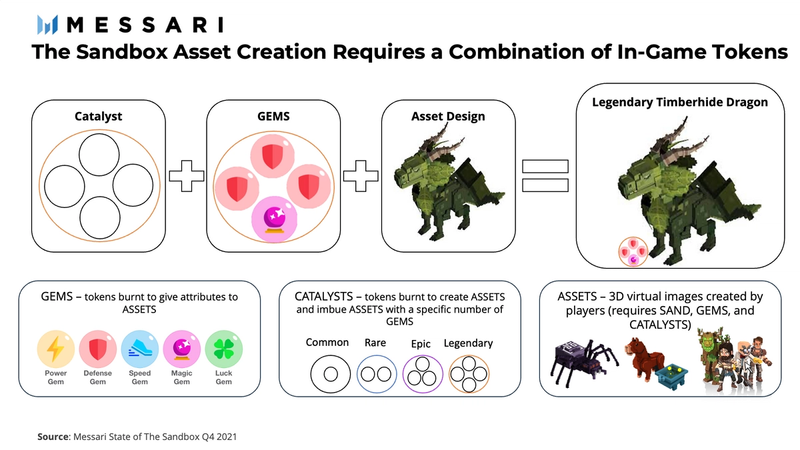
These user-generated assets are ERC-721 non-fungible tokens that can be monetized on open markets. The Sandbox ecosystem leverages a series of tokenized gaming features including: a digital in-game currency used for purchases, monetization, and asset creation (i.e., SAND); ownable digital land within The Sandbox virtual world (LAND); a combination of LANDs to create a larger plot (ESTATE); a bundle of assets and scripting logic to create interactive experiences (GAMES); 3D virtual images created by players (ASSETS); tokens burnt to give attributes to assets (GEMS); and tokens burnt to create ASSETS (CATALYSTS). Thanks to the tradeable nature of these user-generated assets within its virtual world, The Sandbox has robust in-game economics.
In addition to owning the assets that they build, creators will be able to make experiences available on LAND parcels in The Sandbox Metaverse. The long-term goal of The Sandbox is to enable creators to build immersive experiences. The possibility to monetize LAND and in-game experiences has attracted investors to acquire LAND. The top owners of LAND include large investors in The Sandbox, such as Binance, Everyrealm, and Galaxy Interactive, as well as NFT communities such as Whale, MetaKovan, and Cyber Kongz. In addition, The Sandbox is actively forming partnerships with businesses that are willing to develop experiences within its virtual world and become early adopters. These partnerships span a suite of business verticals including gaming, music, entertainment, fashion, and lifestyle, to name a few. Partnership examples are presented in “The Sandbox Ecosystem: Notable Events” section below.
Macro Overview
There is a finite amount of Sandbox LAND — 166,464 parcels. New LAND parcels are subject to primary sales — they are sold to private entities (in partnerships) or released for sale through auctions. Notably, 65% of all the LAND parcels have already been distributed, up 2% from Q4 2021.
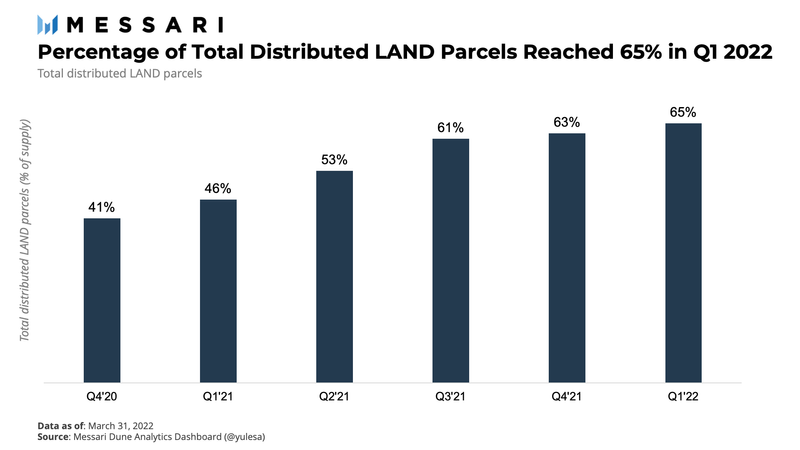
As the volatile Q1 2022 has come to a close, LAND secondary sales volume decreased by 54% compared to the previous quarter. To put this into perspective, the secondary sales volume in Q1 2022 is still up 865% relative to Q3 2021. This quarter’s decrease is the result of the metaverse hype starting to settle down since Meta’s rebrand announcement in October 2021. The market is merely finding its equilibrium, and demand for LAND remains healthy despite the buying frenzy of Q4 2021.
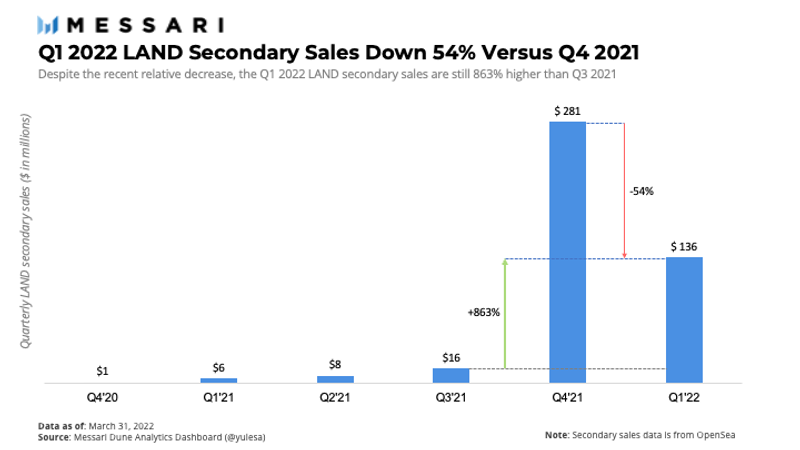
At the same time, relative to Q2 2021, primary LAND sales grew 23%. The subject of primary sales are LAND parcels that are newly issued and are usually either sold to partners or through auctions. Still, primary LAND sales volume ($16 million) accounted for only 12% of the marketplace LAND sales volume ($136 million) in Q1 2021.
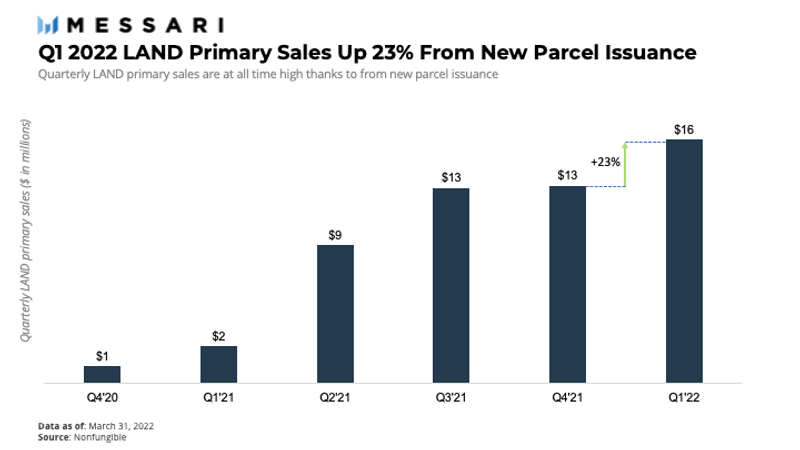
In terms of usage, The Sandbox launched the Alpha Season 2 of its gameplay in March 2022. Notably, during this launch, The Sandbox reached 2 million registered users. Considering the launch lasted four weeks, tracking its active daily or monthly users isn’t useful at this point. Instead, unique LAND buyers may be an alternative proxy for the interest in LAND utility.

The number of monthly active LAND buyers is back to the more sustainable levels seen before Meta’s announcement in late October 2021. This poses the question of what drives the value of digital land in The Sandbox virtual world, given that only a limited number of its users are currently being able to host and monetize experiences.
In our previous quarterly report, an in-depth analysis uncovered that LAND ownership is fairly concentrated, with the top owners holding onto their parcels. A follow-up question is whether this holding behavior is specific only to top owners. This quarter’s report analyzes the LAND holding time and discusses the potential implications on the value of land in virtual worlds.
Micro Overview — Holding Behavior
In an effort to understand LAND holding time, one may consider various clusters of buy & hold behavior. In this sense, one can think, for instance, of long-term buying behavior as holding onto parcels for longer than one year, while buy & sell could be described as holding periods shorter than 30 days. The current breakdown of the LAND holding time reveals that 7% of purchasers hold LAND for longer than one year, while 11% of purchasers hold LAND for less than 30 days. At the same time, the vast majority (72%) of LAND buyers hold the asset for 1–3 months.
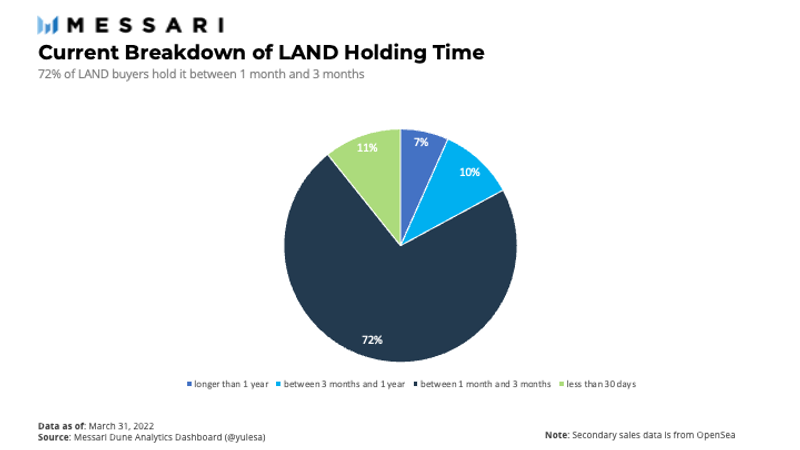
In other words, 83% of buyers choose to sell their LAND sooner than 3 months after the purchase. This hints towards profit taking as a driver for LAND owners to buy & sell their assets. Below we analyze the profit taking behavior by looking at buy & sell transactions that took place within 30 days. For each of these buy & sell transactions, the difference between the sale price and the corresponding buy price is summed up on a daily basis.
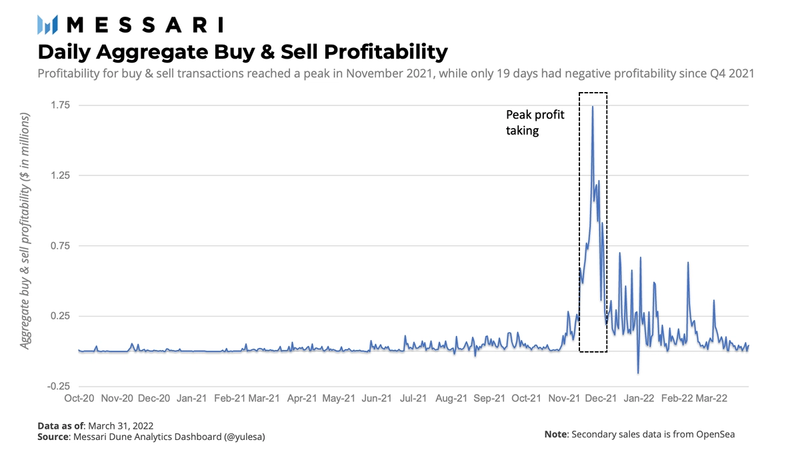
Note that peak profit taking occurred on Nov. 24, 2021 — roughly one month after the Meta rebrand announcement. Since then, profit-taking behavior returned to sustainable levels. Additionally, since October 2020, only 19 days have seen negative aggregate profitability, with Dec. 31, 2021 having the largest negative balance. One may consider LAND buying potentially as a call option on The Sandbox gaining massive user traction.
Despite the high interest in The Sandbox gameplay experiences signaled by the 2 million user registrations, the case for digital land is still in its early days in terms of the building of experiences. Intuitively, making immersive experiences available in The Sandbox may be a potential catalyst for sustainable value creation and capture. In this sense, users are eagerly awaiting immersive crypto-consumer gameplay experiences to be launched. Creators are well positioned to build immersive virtual experiences and make them available for users. In terms of capturing that value, owners may acquire specific LAND parcels with the hope that hosting virtual experiences on those parcels may, in turn, drive increased user activity. This could further create a flywheel for immersive experiences to be adopted on a large-scale, which, in turn, would boost the value of LAND parcels over the long-term.
However, it is not presently possible for creators to make experiences available to others using LAND parcels. This may hinder real demand for the time being. While most LAND buyers may be initially inclined to hold, the absence of practical means to monetize LAND though hosting of experiences may tempt them to take profits. It is thus important for The Sandbox to continue building the backbone for immersive experiences and increased accessibility by users.
For The Sandbox to continue to grow and thrive, immersive experiences will need to be created and adopted on a large-scale. In this sense, an important metric to follow will be the number of active users of full gameplay releases that are not bound to specific time intervals.
The Sandbox Ecosystem: Notable Events
Partnerships
Brands show no signs of fatigue in joining The Sandbox ecosystem. Driven by the vast possibilities of building and monetizing experiences, a series of brands have announced partnerships with The Sandbox on several verticals, notably: gameplay (Ubisoft, SM Media, and Ethernity), music (Warner Music Group), entertainment (SHIBUYA109), diversity and inclusion (World of Women), sports and gaming engagement (HSBC), and fashion and lifestyle (Gucci, Arianee). Developing further partnerships will remain a focus area for The Sandbox for the foreseeable future.
The Sandbox Alpha Season 2
In March of 2021, The Sandbox launched Alpha Season 2 of its virtual world. The gameplay was bound to 4 weeks and enabled users to get Alpha Passes and earn SAND, the utility and governance token of The Sandbox. For the first time, The Sandbox reached the milestone of 2 million registered users. As part of Alpha Season 2, The Sandbox released 200 quests and 35+ experiences that were available to PC and Mac users that registered with a free account. The Sandbox looks to continue growing its user base with the upcoming Season 3 announcement.
Staking on Polygon
The Sandbox introduced gasless mSAND staking in February. While SAND already maintains a liquidity pool on Uniswap, this program allows everyone on Polygon to get a share of the 500,000 mSAND weekly rewards. In addition, mSAND holders who provide liquidity to the program will be eligible to share a monthly allocation of 500,000 mSAND. Further staking rewards have been introduced during The Sandbox Alpha Season 2.
Roadmap
Looking ahead, The Sandbox has a few notable developments in the pipeline.
Progressive Decentralization
Through progressive decentralization, The Sandbox aims to incentivize its community to come up with their own experiences. That is, The Sandbox is inspiring its community to build experiences for players and potentially unleash the next generation of massively successful games. While not yet deployed, The Sandbox DAO will be able to vote on Foundation grants as well as make decisions on game developments. The Sandbox DAO will be governed by both SAND token holders and LAND owners.
Network Effects and Ecosystem Growth
As LAND will continue to be gradually opened and distributed in 2022, The Sandbox needs to grow its network effects. There will be a sustained effort in securing further partnerships and growing its ecosystem. The aim is to scale and attract various businesses — metaverse agencies, fashion houses, virtual real estate marketplaces. Ideally, these businesses would establish their own sales, leading to job creation and a wider variety of experiences available to players in The Sandbox.
Launch of Public In-Game Experiences
The Sandbox is still in alpha, which means that in-game experiences are presently unavailable. Once available, these in-game experiences are expected to further grow The Sandbox user base. Throughout the following quarters, The Sandbox plans to allow users to publish experiences directly on their LAND parcels so that other players can access them.
Closing Summary
The Sandbox ecosystem continued its growth in Q1 2022, with notable partnerships and over 2 million registered users upon launching the Alpha Season 2 gameplay. This past quarter, The Sandbox also experienced the effects of the overall market pullback. As the metaverse hype started to settle down, marketplace sales of digital land came back to sustainable levels. The ambitions of The Sandbox are wide-ranging, with the potential to become one of the largest experience-based entertainment platforms.
Based on its numbers and partnerships, The Sandbox remains at the forefront of virtual worlds. But, there remain some potential headwinds. The real test for the long-term viability of The Sandbox is building the technology backbone for more immersive experiences for its future players. With the success of the Alpha version launch, now is the time to test what works, track the adoption of features, and to be strategic about the roadmap and its execution. The ability to quickly pivot and adopt the most suitable strategy for the technical development of its virtual world will be key. For The Sandbox to become a true entertainment metaverse, immersive experiences will need to be created and adopted on a large-scale.
This report was commissioned by The Sandbox, a member of Protocol Services. All content was produced independently by the author(s) and does not necessarily reflect the opinions of Messari, Inc. or the organization that requested the report. Paid membership in Protocol Services does not influence editorial decision or content. Author(s) may hold cryptocurrencies named in this report.
Crypto projects can commission independent research through Protocol Services. For more details or to join the program, contact ps@messari.io.
This report is meant for informational purposes only. It is not meant to serve as investment advice. You should conduct your own research, and consult an independent financial, tax, or legal advisor before making any investment decisions. Past performance of any asset is not indicative of future results. Please see our terms of use for more information.















